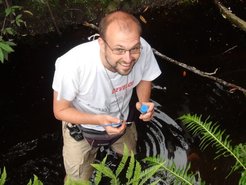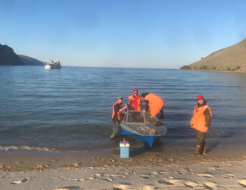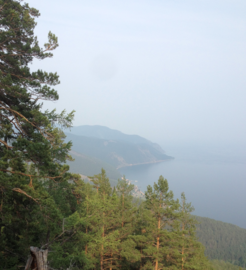Fieldwork

Miquel in the ditch in Tasmania.
The planarian model species Schmidtea mediterranea is but one of many hundred planarian species that occur worldwide in streams, ponds, lakes or marine habitats, but also on land in forests and moist grasslands. Each species comes with its unique genome and a unique set of adaptations to a specific ecological niche. We are deeply fascinated by the phenotypic diversity of planarians, both in terms of exploring the underlying molecular mechanisms, but also in terms of the ecological and evolutionary mechanisms that ultimately determine why specific phenotypes emerge.

Sampling at Lake Baikal, Russia.
As a precondition for studying planarian biodiversity, department members regularly embark on world-wide field sampling expeditions (with Australia, Macedonia, Sardinia, Siberia and Caribbean islands included amongst our past destinations). The development of suitable culture conditions and the eventual integration into our departmental species collection constitutes one goal of our sampling activities. The group of Dr. Miquel Vila-Farré that is associated with the department studies planarian taxonomy and describes the new species that we encounter in the field.

The village of Bolshiye Koty, our field work base camp at Lake Baikal.
The department has also started to establish a field station at Lake Baikal in Russia, which is made possible by a joint project between the Max Planck Society and the Irkutsk Limnological Institute of the Russian Academy of Sciences. This project is currently paused due to the Russian invasion of Ukraine.
With more than 50 taxonomically described planarian species, Lake Baikal is the single most significant hotspot of planarian biodiversity on the planet. Moreover, its tremendous radiation of planarians has brought about giant species with ~40 cm body length, species adapted to live in the abyssal zone (> 1000 m water depth) and striking variations in pigmentation patterns or visual system morphologies, for example. Thus, the Baikal project amounts to an opportunity to examine the molecular, evolutionary and ecological dimensions of a rather recent species radiation.


